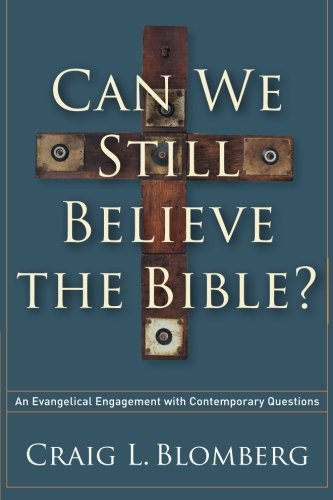The second major chapter of Craig Blomberg’s book deals with the issue of how we got the NT, or put another way, how the canon of the NT came about. Was the NT canon a product of the politics of Constantine and his cronies? Was it the product of the winners in the heresy wars? Or was it something else altogether?
Craig begins this chapter by again quoting some of the misinformation one can derive from read Bart Ehrman on how we got the NT canon. To be fair, Bart has changed some of his views on these matters, for example recently he agreed with Larry Hurtado that worship of Jesus as divine can be traced back to the very earliest stages of the formation of the Christian movement. Nevertheless, he still thinks early Christianity was like dueling banjos, and that the discordant and out of tune players were edited out or their contributions sublimated by the orthodox in the 4th century A.D., who ‘rewrote the history’ as well as winning the battles for orthodoxy. In fact, this is not quite correct on either counts.
Blomberg first points out that we really have no truly heterodox documents from the first century A.D. No Gnostic texts go back to the first century, no Montanist texts go back to the first century, and so on. Heterodoxy is after all derived from and parasitic on and draws on the earlier forms of Christian teaching. The documents we have in the NT itself all date to the first century A.D. or in 1-2 cases maybe the very early years of the second, as is agreed by most NT scholars of all stripes, and anything that was either not by 1) an apostle, not by 2) one of the Twelve, not by 3) an eyewitness or not by 4) an associate of 1)-3) was not included in the canon of the NT. Apostolic and early was the criteria applied to Christian documents, and even the writers of the early second century like Ignatius, recognized that though their own writings might be authoritative, they were not apostolic, and were not to be treated in the same way as the early apostolic and eyewitness documents. The diversity in the early church between more Jewish and more Gentile expressions of the faith ranging from Pharisaic Jewish Christians (everyone needs to be circumcised and become a Jew to follow Jesus) to anti-nomians at the other end of the spectrum with the Apostles, the family of Jesus, and Paul somewhere in between, is of a very different sort than when we get to the second century and begin to have Gnostic and Marcionite and Montanist re-readings of the original and earliest Christian traditions. So as Craig says “Only beginning in the second half of the second century does literature begin to emerge of a very different kind, and it presupposes the earlier existence and widespread usage of the NT documents. The most fanciful and unorthodox documents do not emerge until the third through fifth centuries.” (p. 44). This is exactly right. Even the Gospel of Thomas cannot really be dated earlier than the late second century because it draws on all four canonical Gospels for its materials, and knows the final editing of those documents to boot.
One of the better arguments in this chapter is counter to the argument that Ehrman makes about the NT itself namely it reflects great theological diversity and contradictions— dueling banjos, and yet at the same time he wants to argue that it was put together by the orthodox winners of the heresy wars who imposed their views on things, eliminating the wider diversity of the movement’s documents.
As Blomberg, following Michael Krueger says— you can’t have it both ways (see p.60). Either the canon reflects the great diversity of earliest Christianity or it does not. Either it was shaped by the later orthodox or it was not. If you argue for the latter and that they deliberately excluded the truly diverse documents and voices, then the argument that the canon reflects the earlier diversity won’t stand. On the other hand, if the NT reflects a basic theological and ethical unity, then this can be explained on the basis that the earliest movement had such a unity just as well as the suggestion that it was later imposed by the selection of these documents.
On p. 67 Blomberg rightly points out, neither Constantine, nor the Council of Nicaea in 325 A.D. decided which books belonged in the NT canon. Eusebius, who was present there would have included the present 27 books, even though some of them were debated (e.g. 2-3 John). There is no evidence of any debate about any of the Gnostic documents. Only the Gospel of Thomas appears in exactly one approved reading list, and no Gnostic documents appear in any canon lists at all. On p. 70 Blomberg points out the sad irony that some Muslims based various of their views of Jesus on the 14th century Gospel of Barnabas, but no trace of this document has emerged from earlier than the 14th century.
From about pp. 70-74 there is a careful critique of the Gospel of Thomas, and what emerges is not only that it is from the late 2nd century A.D. but that it is clearly an early Gnostic text (see Saying 56), and a patriarchal and anti-Semitic one at that. The prominence of Mary Magdalene partially reflects her prominence even in the ministry of Jesus (see John 20 especially), but one needs to bear in mind this has nothing to do with her gender, which in saying 114 is said to be overcome-able— Jesus will make her a male!!
On p. 76, after discussing the problems with the argument for supplemental Scriptural books (i.e. the Koran or the Book of Mormon) Blomberg rightly stresses the following— “the only way Muslims or Mormons have been able to justify another collection of divinely inspired literature is to claim either: 1) that the existing texts of the NT are corrupt and originally taught something quite different (the typical Muslim claim), or 2) that entire books were left out of the canon that God originally gave to his people (the typical Mormon claim)….there is not a shred of historical evidence to support either of these claims”. As a sad footnote to this, I have had Coptic Christians and others in Egypt write me telling me that Bart Ehrman’s Books, translated into Arabic have been used as a justification to persecute and ridicule Christians and their faith in that context. How sad is that!
There is at the end of each chapter in this book an ‘On Avoiding the Opposite Extreme’ which is useful as well. In this chapter it is about the Bible not being a textbook on all sorts of subjects, including math etc. and of course Craig is right. It is also not a textbook on politics, economics, dating, counseling, farming, aging etc.
One of the real values of a book like this is that it is written not only by a very well seasoned NT scholar, but also an apologete who has heard most every kind of false claims about the Bible that have emerged in the last half century. He responds to those claims not with polemics and mere rhetoric but with facts, and careful analysis. And time and again what emerges is— the Emperor has no clothes! By which I mean, the critics and pundits, and polemicists don’t even have their facts right. As a wise man said, while it may be true that ‘you are entitled to your own opinions’ you are not entitled to ‘your own facts’. Facts are a public commodity, and distorting Christian theology and Christian history and the history of translations and the history of the canon will eventually come a cropper, will eventually be shown to be simply false. And Craig has done a good job on aiding that process. But next we turn to the wars over translations, sadly 🙁













